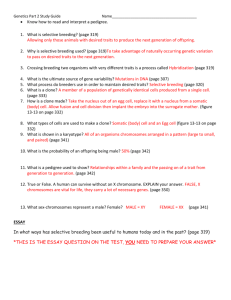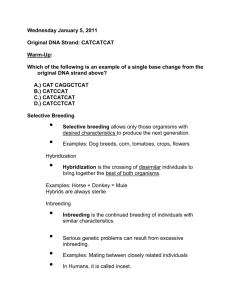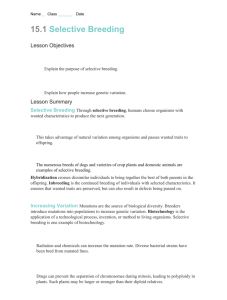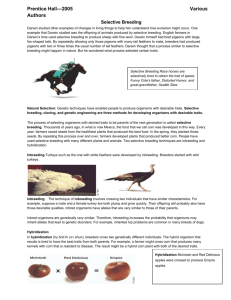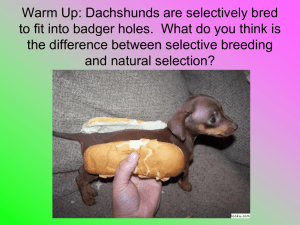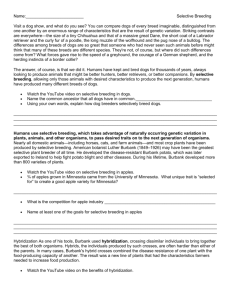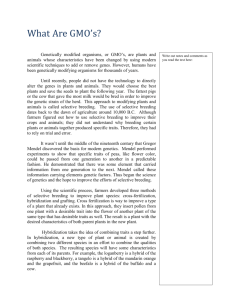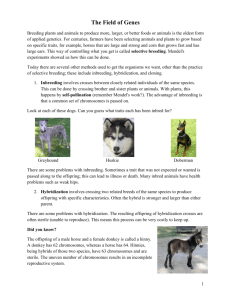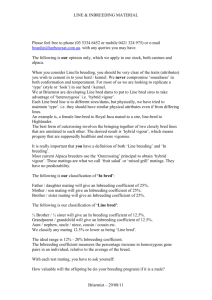Selective Breeding
advertisement
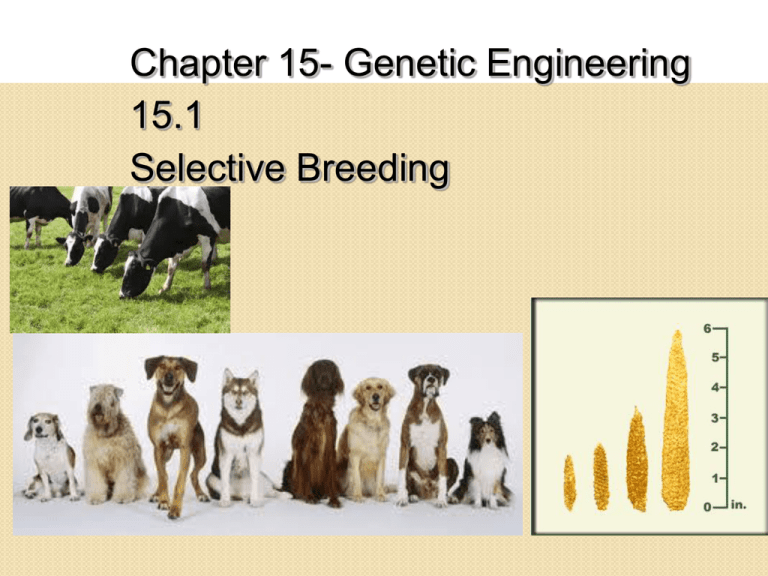
Chapter 15- Genetic Engineering 15.1 Selective Breeding What is this?? Why did humans create this type of car?? Selective Breeding ◦ The differences among breeds of dogs are great. Where did these differences come from? ◦ @Humans use selective breeding to produce animals with certain desired traits.@ Selective breeding allows only those animals with wanted characteristics to produce the next generation. Selective Breeding ◦ For thousands of years, we’ve produced new varieties of cultivated plants and nearly all domestic animals by selectively breeding for particular traits. ◦ Native Americans selectively bred teosinte, a wild grass native to central Mexico, to produce corn, a far more productive and nutritious plant. ◦ There are two common methods of selective breeding—hybridization and inbreeding. How we’ve used Selection b. Dogso o c. Tiny Chihuahuas and Huge Great Danes Labrador retrievers with short coats and poodles with curly hair. Humans are always looking to make animals that are better hunters, better retrievers or more capable of producing a quality product. Hybridization ◦ American botanist Luther Burbank developed more than 800 varieties of plants using selective breeding methods. ◦ One method Burbank used was @hybridization, crossing dissimilar individuals to bring together the best of both organisms.@ ◦ Hybrids—the individuals produced by such crosses—are often hardier than either of the parents. Hybridization ◦ Many of Burbank’s hybrid crosses combined the disease resistance of one plant with the food-producing capacity of another. ◦ The result was a new line of plants that had the traits farmers needed to increase food production. Inbreeding ◦ @To maintain desirable characteristics in a line of organisms, breeders often use inbreeding@, the continued breeding of individuals with similar characteristics. ◦ The many breeds of dogs are maintained using inbreeding, ensuring that the characteristics that make each breed unique are preserved. Inbreeding ◦ Inbred organisms are genetically very similar and can increase the probability that organisms may inherit genetic disorders. Increasing Variation ◦ When scientists manipulate the genetic makeup of an organism, they are using biotechnology. ◦ Biotechnology is the application of a technological process, invention, or method to living organisms. ◦ Selective breeding is one form of biotechnology important in agriculture and medicine, but there are many others. Bacterial Mutations ◦ @Mutations occur spontaneously, but breeders can increase the mutation rate of an organism by using radiation or chemicals.@ ◦ Many mutations are harmful to the organism, but breeders can often produce a few mutants—individuals with mutations—with useful characteristics that are not found in the original population. ◦ For example, scientists have developed hundreds of useful mutant bacterial strains by treating bacteria with radiation or chemicals. ◦ Certain strains of oil-digesting bacteria are effective for cleaning up oil spills, and scientists are currently working to produce bacteria that can clean up radioactive substances and metal pollution in the environment. Polyploid Plants ◦ Drugs that prevent the separation of chromosomes during meiosis are very useful in plant breeding. These drugs can produce cells that have many times the normal number of chromosomes. ◦ Plants grown from these cells are called polyploidy, they have many sets of chromosomes. ◦ Polyploidy is usually fatal in animals, but plants are much better at tolerating extra sets of chromosomes. Polyploid Plants ◦ @Polyploidy can quickly produce new species of plants that are larger and stronger than their diploid relatives.@ ◦ A number of important crop plants, including bananas, have been produced in this way. Crossing individuals with different traits to bring together their best characteristics is called a. domestication b. inbreeding c. hybridization d. polyploidy Crossing individual with similar characteristics so that those characteristics will appear in their offspring is called a. inbreeding b. hybridization c. recombination d. polyploidy Taking advantage of naturally occurring variation in organism to pass wanted traits on to future generations is called a. selective breeding b. forensics c. gene therapy d. mutation
